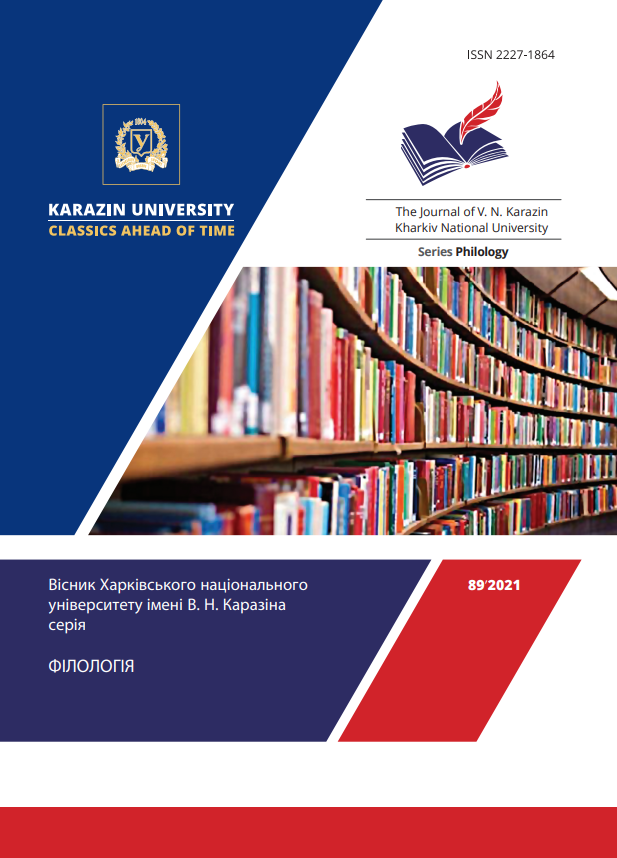Children's trauma as an element of a literary work for children and youth
Abstract
The research studio is devoted to the analysis of the connection as a compositional element of a literary work for children and youth.
The issue of modern children's literature largely focuses on issues related to children's trauma, which underlies the development of the plot of the work and the characteristics of the characters. In view of this, the «child trauma» in the article is seen as an emotional state of the protagonist, who found himself in a difficult psychological situation, where the child's usual state of affairs is disturbed - loss of family members or withdrawal from traditional living space. An important element of the plot and character development of the protagonist is the need to make difficult life choices or violate established prohibitions.
It is worth noting that an important factor in raising a child and forming models of his behavior for many centuries was folk art, which demonstrated the necessary rules of human behavior in certain difficult life circumstances. At the same time, one of the leading genres of folk art, which influenced the formation of human character, was a fairy tale that presented certain patterns of behavior in crisis situations, as well as provided advice to combat injuries, including psychological.
According to the results of the study it was found that the basis of the popular adventure works of D. Tolkien, K. Lewis, R. Dahl, D. Rowling, R. Riordan, S. Mayer, T. Timayer, N. Scherba and B. The image of a child's injury is missing. This technique is also characteristic of folklore and mythology.
Downloads
References
Dal, R. (2017). James and the giant peach. Kyiv: A-ba-ba-ha-la-ma-ha. 224 p. [in Ukrainian].
Dal, R. (2006). Matilda. Kyiv: A-ba-ba-ha-la-ma-ha. 272 p. [in Ukrainian].
Dal, R. (2009). Charlie and the chocolate factory. Kyiv: A-ba-ba-ha-la-ma-ha. 240 p. [in Ukrainian].
Kuhn, M. (1993). Legends and myths of ancient Greece. Ternopil: Joint-stock company «Tarnex», with the participation of a small enterprise «Mallows». 416 p. [in Ukrainian].
Naumets, I. (2020). How a child's trauma affects adult life? URL: https://neuronews.com.ua/ua/issue-article-1951/Yak-dityacha-travma-vplivaie-na-dorosle-zhittya#gsc.tab=0. [in Ukrainian].
Nestayko, V. (2010). Amazing adventures in the forest school. Kharkiv: School. 208 p. [in Ukrainian].
Riordan, R. (2016). Percy Jackson and the Olympian gods. Kharkiv: Ranok, 496 p. [in Ukrainian].
Rowling, D. (2002). Harry Potter. Kyiv: A-ba-ba-ha-la-ma-ha. 320 p. [in Ukrainian].
Tolkien, J.R.R. (2004). The Lord of the Rings: The Fellowship of the Ring. Kharkiv: Folio. 432 p. URL: https://www.ae-lib.org.ua/texts/tolkien__the_lord_of_the_rings_1__ua.htm. [in Ukrainian].
Boyko, V. (1976). Ukrainian folk tales. Kyiv: Dnipro. 340 p. [in Ukrainian].
Alekseenko, L. (2010). Magic well. Tales. Uzhhorod: Patent. 264 p. [in Ukrainian].
Scherba, N. (2014). Chasodia. Kharkiv: Shkola. 352 p. [in Ukrainian].
Emets, D. (2003). Tanya Grotter. Moscow: Exmo. 381 p. [in Russian].
Lewis, K. (2020). The Chronicles of Narnia. The complete history of the magical world. Kharkiv: Family Leisure Club. 912 p. [in Ukrainian].
Mayer, S. (2010). Twilight. Kyiv: KM-BUKS. 384 p. [in Ukrainian].
Propp, V. (1928). Morphology of a fairy tale. Leningrad: ACADEMIA. 152 p. [in Russian].
Timayer, T. (2016). Chronicles of world seekers. Kharkiv: Ranok,. 400 p. [in Russian].
The National Child Traumatic Stress Network. (2020). What is childhood trauma? URL: https://www.blueknot.org.au/Resources/Information/Understanding-abuse-and-trauma/What-is-childhood-trauma. [in English].




